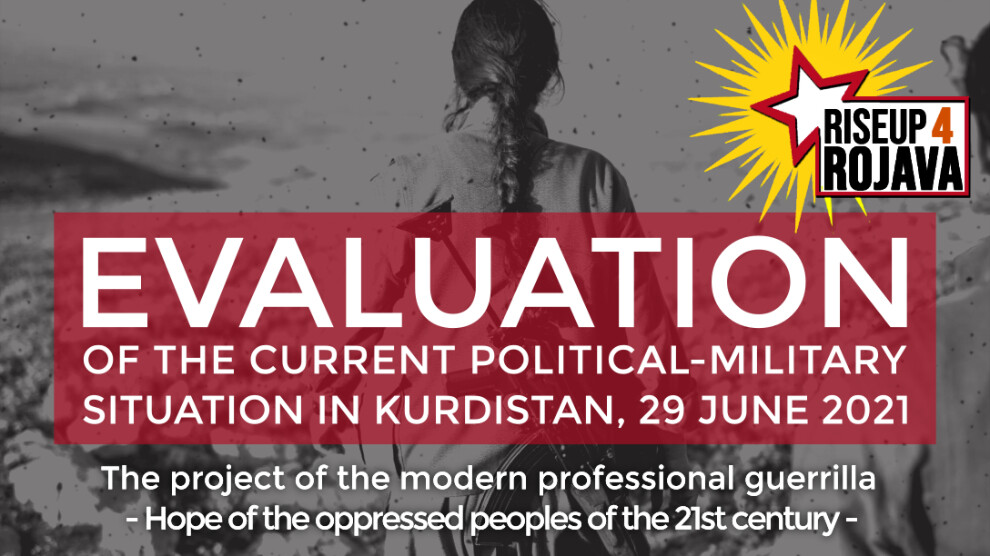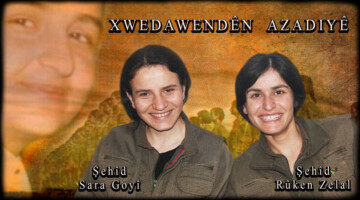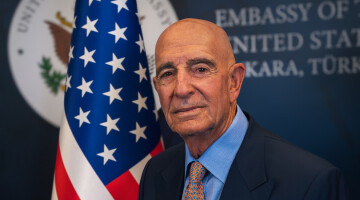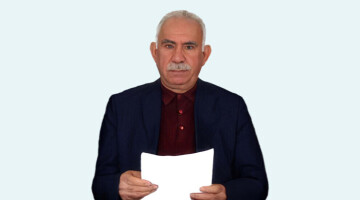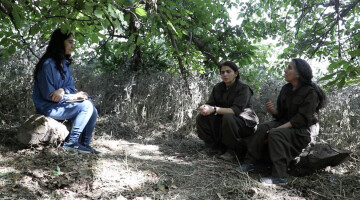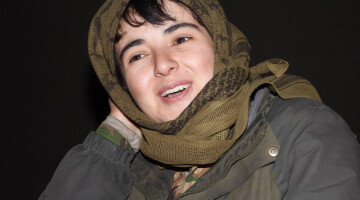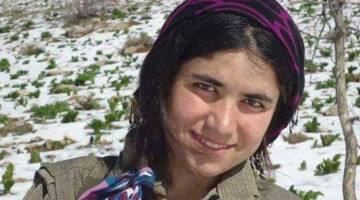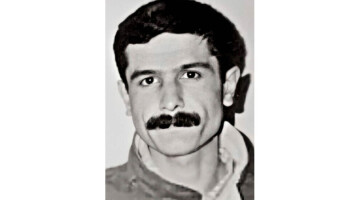RiseUp4Rojava evaluates current political developments in Kurdistan.
We publish the full document below.
Today, we write the 65th day of the heroic resistance of the guerrilla in the border areas of the Medya Defense Areas. On April 23, the Turkish occupation army launched an all-out assault on the guerrilla-controlled regions of Metîna, Zap and Avaşîn. The large-scale operation was named “Claw Lightning and Claw Thunderbolt”. It is an operation that directly joins the spiral of escalation of the last 6 years in which the fascist AKP-MHP dictatorship of Turkey has done everything to break the will of freedom and resistance of the Kurdish people and all anti-fascist forces of the region. This attack is the continuation of the war in the cities of Northern Kurdistan in 2015 and 2016, the invasion in Efrîn in 2018, Girê Spî and Serêkaniyê in 2019, as well as the wars of aggression against the guerrillas in the areas of Xakurkê and Heftanîn.
The concept of “bringing them to their knees”:
Already in October 2014, at the very height of the resistance in Kobanê against IS and while a ceasefire had been prevailing in Turkey and Northern Kurdistan since Newroz 2013, the leadership of the Turkish state decided on the plan “bringing them to their knees” (Plana Çokdanîne). In a nutshell, this plan is about bringing the Kurdish Freedom Movement and first and foremost its vanguard, the PKK, to its knees. Accordingly, all military, financial-economic, and political-diplomatic resources available to the Turkish state have been mobilised for the past 6 years. Erdoğan and the AKP-MHP government see this war as the only way to maintain power and to realise their imperial aspirations.
It was in the late summer of 2014 when the people of Rojava and their defense forces YPG and YPJ heroically stood up against the advance of IS. At the same time, after the KDP's Pesmerga abandoned their positions on all front lines, the HPG and YJA-Star guerrillas in Southern Kurdistan/Northern Iraq rushed to the aid of the Yezidis in Şengal in a historic operation and put an end to the advance of the Islamist gangs on Kerkuk, Maxmur and Hewler. Inspired by the revolution in Rojava and the resistance against IS, millions of people around the world took to the streets and declared their solidarity. A new international movement emerged.
In Northern Kurdistan, in the October uprising from 5th - 9th October, the peoples made the rulers of Turkey tremble in fear and anxiety for a few days. The institutions of the state and government went up in flames and soldiers dared not come out of their barracks. 2014 was a year of hard confrontation and the revolutionary movement grew from it and became stronger and bigger day by day. Rojava successfully resisted and won the heart of many people around the world, in Northern Kurdistan and Turkey masses were organized, the project of the HDP was put into action, in the South the guerrillas gained long unseen popularity through their selfless and self-sacrificing intervention against the IS.
The Turkish state had hoped to use the ceasefire period to soften the movement and to water down its ideological principles, but instead the armed struggle attracted more people than it had done in a long time. In August 2014 alone, Murat Karayilan stated that more than 1,000 men and women had joined the guerrillas in the course of a single month. The resistance in Kobanê remained unwavering despite the seeming superiority of the IS, not least because the guerrillas and hundreds of youth from the North set out, crossed the border into Kobanê, joined the resistance right on the front lines, and for the most part gave their lives to prevent the fall of Kobanê at any cost.
This reality that the Erdoğan government faced in 2014 made it conclude that only a complete suppression of the most dynamic part of the revolution, the people in Northern Kurdistan and an annihilation of the vanguard of this Freedom Movement could secure its existence and power. The people, the guerrilla, the organisational-ideological leadership by the PKK should be “brought to its knees”. As a result of this, Abdullah Öcalan was once again put in complete isolation on the prison island of Imrali from April 2015. Every measure was taken to prevent the HDP from entering parliament in the 2015 elections, though obviously without success, and on July 24 2015, the Turkish occupying army finally began the war phase, which has now lasted for 6 years, by launching an all-out attack on the guerrilla-controlled Medya defense areas in Southern Kurdistan/Northern Iraq. The guerrillas responded by dissolving the cease-fire, which until then had only been declared unilaterally anyway. The people proclaimed autonomous, democratic self-administration in several regions of Northern Kurdistan and founded the Civil Self-Defense Units, YPS. Neither the people nor the guerrillas allowed themselves to be subjugated and brought to their knees, but they continue to stand their ground, defending their dignity. Much has happened since then, but the war continues unabated. Northern Kurdistan, Southern Kurdistan, and Rojava (Western Kurdistan) are connected in this war, even though they have been forcibly separated by physically drawn borders, and this is what we all need to understand. The struggle in the different parts of Kurdistan cannot be considered separately. Without the guerrillas, the revolution in Rojava would never have been possible. The guerrillas defended Kobanê in 2014/2015 and have never stopped being responsible for defending the revolution in Rojava and sacrificing themselves when necessary. The guerrilla is the guarantor of the autonomy of the revolution in Rojava.
The situation and events in the entire region, both the different parts of Kurdistan as well as the occupying states and neighboring countries are inseparably intertwined. On the one hand, this is one of the reasons why the struggle and the situation in the region is so incredibly complicated, on the other hand, this reality proves the enormous potential of a feasible, successful revolution in this region.
With the objective of destroying the guerrillas, the Turkish fascist occupation army launched its operation against the Xakurkê region in 2018, its operation against Heftanîn in 2019 and in 2020, and recently they wanted to deal a heavy blow to the center of the guerrillas by occupying the Gare region this spring.
Gare - The revenge and the victory of the guerrilla
The mountainous region of Gare is a strategically important location for the guerrilla. Unlike Metîna, Avaşîn, Zap, Heftanîn and Xakurkê, for example, Gare is not located on the border with Turkish territory, but further inland to the south. In this respect, Gare has always had the advantage for the guerrillas not to be located on the direct front line, but to offer space for organisational work, educational work, etc., despite air attacks and drone surveillance, as well. On February 10 this year, the Turkish occupation army launched a large-scale operation to invade the Gare region. Initiated and accompanied by massive bombardments and area-wide aerial surveillance, the Turkish army sent hundreds of its special forces with helicopters from the South, i.e. from KDP area, to Gare. On the very first day, they tried to capture the strategic peaks of the area, but failed miserably due to the direct response of the guerrillas. Wherever the Turkish army dropped its soldiers, despite hours of prior bombardments, the guerrillas were on the ground and were hitting the invaders with heavy blows.
It is obvious what the plan was. They wanted to advance into one of the core areas of the guerrillas with this surprise blitz operation, to establish a permanent foothold there. For days, the entire area was bombed from the air without a break. In the cave, where prisoners of war, Turkish soldiers and MIT officers were located, the Turkish army finally used poison gas, killing both its own people and the guerrilla friends, led by Şehîd Şoreş, who had been resisting on the ground for days. After 4 days, however, the highly modern Turkish army, the second largest army in NATO, was defeated and forced to retreat. In this respect, February 14 of this year marks a historic milestone victory for the guerrillas. Once again, it was the guerrillas who defended Rojava. "Why is that?", some may ask now. What does one have to do with the other? After all, Gare is in Southern Kurdistan/Northern Iraq, and Rojava is in Northern Syria. That is correct, but that is not the decisive point here. In Gare, revenge was taken for the occupation of Efrîn, Girê Spî, and Serêkaniyê. The thousands of fallen fighters, the women, children and men murdered by the Turkish state and its henchmen were avenged in Gare.
The myth and the propaganda that even the guerrillas are ultimately powerless against the superiority of the state has been broken once again and has been exposed as a lie. Gare has been a victory for all of us, in Kurdistan and around the world, a victory for all of us who marched side by side with the anti-fascist resistance of the last years and took up the fight against Turkish fascism and its international collaborators in different ways. As much as the Turkish state tries to hide and turn the truth by propaganda lies, as much as they try to break the resistance by the currently ongoing, broad and massive military campaign against the guerrilla, they will not be able to undo our victory, the victory of the guerrilla in Gare. The Turkish army was brought to its knees in Gare and right now it is being brought to its knees everyday in the mountains, in Metîna, in Zap, and in Avaşîn. To avoid embarrassment, the Turkish army resorts to the use of its paramilitary forces, Islamist gangs from Syria, the use of village guards, and the henchmen of the KDP. Less Turkish soldiers, whose fighting morale is broken, are sent to the front, but other forces are sent as cannon fodder. In this context, the KDP plays a central role, having been busy for months encircling the guerrilla areas from the South and provoking an escalation that would bring about a fatal intra-Kurdish war. And even if the KDP deserves to be held accountable for its crimes, such an escalation would be in the full interest and aim of Turkish fascism. The situation is serious and the war is in a critical, decisive phase. The Turkish state is also aware of this and accordingly leaves no stone unturned in order to be able to advance. Chemical weapons and poison gas are also being used by the Turkish army in Metîna, Zap, and Avaşîn to capture the guerrilla's defense tunnels and caves. Despite all this, the guerrilla continues to resist for more than 60 days. At the same time, it is interesting to note that the Turkish fascist state's propaganda, which normally accompanies any military operation, has been relatively modest and reserved this time. Obviously, the decision was made not to make too much of a fuss in order to avoid a possible embarrassment like the one in Gare.
The Concept of the Modern Guerrilla
For 65 days now, the young women and men of the HPG and YJA-Star have been resisting 24/7, around the clock. Confronted with a highly modern armed NATO army, which has received the green light for its campaign of destruction from its NATO partners USA and Europe and is supported by the collaborators of the KDP in South Kurdistan, the guerrillas have nothing more than their will to resist and to win against fascism. It is this will and with it the realisation of the project of a “modern guerrilla” of the 21st century that ensure that even after 65 days the Turkish state still has no significant territorial gains to record. The victory in Gare and the unbroken resistance of the guerrillas are the result of the revolutionary determination of the Apoist guerrilla, as well as the restructuring and reorganisation of the last years towards a modern, professional guerrilla. The ability of the HPG and YJA-Star to hold their territories in Southern Kurdistan until today and to continue to be active in all areas of Northern Kurdistan is primarily related to this professionalisation.
The concept of the modern guerrilla no longer builds solely upon classical guerrilla tactics, but professionalises itself in all points of war and revolution. The modern guerrilla must be firm in one' s ideological-political convictions, determined for the construction of socialism in the 21st century: a guerrilla of democratic modernity, a guerrilla of democratic, ecological society and of women's freedom. The modern guerrilla must be a soldier: That is, to be disciplined, organised, and structured. The modern guerrilla must know the enemy and know oneself, move according to the circumstances and conditions, and be specialised in the weaponry at one' s disposal. The fundamentals of the classical guerrilla still apply, but the modern guerrilla organises oneself according to the ever-evolving technical capabilities of the states and rulers. As a result, the modern guerrilla finds its own creative responses to the ever-changing characteristics of war today. Although quantity does not lose its importance, in modern warfare quality takes precedence over quantity, and this is especially true of the guerrilla. One of the main reasons why the Kurdish Freedom Movement continues to be internationally criminalised, politically-diplomatically-economicly marginalised and isolated, why the U.S. and Europe support and fund Turkey's war against the PKK by all means, why Abdullah Öcalan continues to be held in isolation, and why Rojava is not given official status internationally, is the radiating strength that a successful guerrilla struggle against a NATO state could have in the 21st century. The imperialists are afraid that the 21st century model of "modern and professional guerrilla" could become an example and model for other peoples and social struggles around the world. Imagine, if they already have such big problems with the guerrilla in Kurdistan and fail to destroy the PKK for more than 40 years, what would happen if 2, 3, many modern guerrilla movements emerge in different parts of the world? What if 2, 3, many fighting movements would adopt this model?
The situation of Turkey, the war in Kurdistan, and NATO
NATO led by the U.S. are afraid of such a scenario. A socialist guerrilla defeating a NATO army in the 21st century? A horror scenario for the capitalist rulers. After all, wasn't it only 30 years ago that the flag of socialism was supposedly laid to rest? Wasn't the end of history proclaimed? The painful answer for the capitalists is: In Kurdistan, in the war against NATO, in the resistance against Turkish fascism, history continues to be made with self-confidence and nothing has been decided yet; those who were believed dead are alive.
We know the history of NATO's special warfare in the 20th century, in the course of which everything had been done worldwide to liquidate, to destroy, to assimilate, and to liberalise communist and socialist movements. Turkey was and is also a place of intense special warfare. Coups, pogroms, state-coordinated media, torture, massacres, extra-legal executions, paramilitary terror, mass arrests, lies, drugs, prostitution, corruption, blackmail, etc. - these are all part of the fixed repertoire of the Turkish state, are part of the fixed repertoire for maintaining power of every NATO member. This is nothing new, becomes however more topical by the public disclosures of the Contra Sedat Peker - who shares for some time over Youtube parts of his knowledge to the general public, concerning the scheming of the deep state in Turkey and the participation of different personalities in these schemes. It is obvious that a serious power conflict within the Turkish state can be seen behind it, and it is also clear that Erdoğan is to be put under pressure. But it shows the critical situation in which Turkey finds itself. The economy has been going downhill for years, and if it had not been for the regular financial injections from the EU and the U.S., Turkey would probably no longer have been able to stand on its feet so easily. Domestically, it is boiling; the Erdoğan-Bahceli government could preserve its own power over years - by false promises on the one hand, and brutal repression on the other hand -, but history shows that this will not go on forever. In terms of foreign policy, Turkey likes to show itself self-confident and independent, but is ultimately dependent on the goodwill of the United States and the powerful players in the EU, i.e. Germany and Great Britain.
Even though Turkey presents itself as militarily invincible and has made a name for itself in recent years with a wide variety of foreign deployments, such as in Armenia-Karabakh, Libya, Northern Syria, and Northern Iraq, the war is pulling immensely on the forces of the state. The resistance of the Kurdish Freedom Movement is not giving Turkey a break, is draining its economic, political, diplomatic, and social resources. Turkish fascism is on the edge of a cliff, and is clinging with all its force to the leg of the imperialist superpowers to prevent it from slipping. The AKP-MHP government may not show this openly, and the state-coordinated media may paint a different picture, but the reality alone that, as explained by Murat Karayilan from the General Command of the HPG, the Turkish state has tried several times in recent months through intermediaries to get the PKK to declare a ceasefire, even with the offer that if the guerrillas would withdraw from Northern Kurdistan, then they could do what they wanted in the other parts of Kurdistan, explains the situation of Turkey very well.
It is true that it is a difficult time in Kurdistan. Every day, great women and men, comrades are losing their lives on the various fronts in Kurdistan. NATO, led by the USA and executed by Turkey, continues its campaign of destruction against the PKK and the Kurdish Freedom Movement. Whether Democratic or Republican administration in the US, the words may be different, but the strategy remains the same - this was made clear right after Biden took over the presidency by giving the green light to the operation in Gare. Just recently, the bounty on leading comrades of PKK, which had existed since 2018, was renewed and at the same time the currently ongoing war in Metîna, Zap , and Avaşîn was started.
Our fighting comrades in Kurdistan who are striving for freedom are going through a difficult time. In the mountains, the guerrillas live under constant aerial surveillance, which means death if they make a wrong move. The buzz of drones and the thunder of F-16 jets hardly breaks. It is precisely this difficult time that requires us internationally to do everything in our power to support the resistance. It is also precisely this difficult time that holds great hope for the destruction of Turkish fascism.
The Role of the KDP: Treason and Collaboration
The role of the KDP in particular during this period is a critical one. For years, it has been busy serving Turkey and especially Turkish intelligence. With the excuse of conducting political-diplomatic-economic relations with the neighboring state for the benefit of its own people, large parts of South Kurdistan have been directly or indirectly handed over to Turkey. Dozens of Turkish military bases have been established, and the MIT moves and behaves in Hewler/Erbil, Duhok, and Zaxo just as it does in Ankara, Istanbul, and Izmir. Turkey and in particular the AKP consider South Kurdistan up to Mosul and Kerkuk as part of their territory to be claimed and are determined to create facts in the region by 2023, the 100th anniversary of the Treaty of Lausanne, which will allow them to expand their own borders. The biggest obstacle to this is the PKK and its guerrilla.
The Treaty of Lausanne was the final international treaty that settled Turkey's borders after the collapse of the Ottoman Empire in 1923. Erdoğan, together with the AKP, has been claiming on behalf of Turkey for years the previously dominated territories of the Ottoman Empire before the Treaty of Lausanne was decided, repeatedly claiming that Turkey was cheated out of its land at the time. Now the KDP, led by the Barzani clan, has opened the door to Turkey in every respect for years, and Turkey is behaving towards South Kurdistan as if it were another district under its administration. This is not new: back in the 1990s, Turkey (with NATO's approval) used the KDP's pesmerga to deter the guerrillas from their offensive in the North and to wear them down with a two-front war. In addition to the intelligence surveillance work in the South, which in recent years has repeatedly allowed Turkey - as they say - to "eliminate" friends of the guerrilla, including in particular some of the leadership members, Turkey has been using the KDP for months to encircle and to constrict the Medya defense areas and to cut off the different areas from each other. At the same time, it is intended with this to provoke a war between the KDP and the PKK.
The KDP is compliantly playing along in this game with fire, but it is not declaring war on its own; instead, through provocations, lies, and plots, it is trying to put the guerrilla in a position where they have to attack in order to be able to blame the PKK for a so-called "fratricidal war" , and thus defame and delegitimise the PKK in all parts of Kurdistan and the diaspora. Obviously, all this is done in coordination and with the approval of the USA, Great Britain, and Germany. The imperialist powers have decided to destroy the PKK at any cost. The KDP itself sold itself decades ago anyway and made its own existence dependent on the cooperation with the occupiers of Kurdistan and the imperialists.
In summary, we can define PKK and KDP as the concrete expression of two fundamentally different lines in Kurdistan. Seen in this way, the KDP is the expression of treason against one’s own people and collaboration with the enemy, while the PKK is the expression of consistent resistance and unbroken attachment to one's own country and people. This distinction describes the current situation in the region and the position of the various forces.
The Guerrilla Is Not Alone - We Stand Behind Them
NATO, Turkey, and the KDP are pursuing a strategy of isolation and division. Geographically, the guerrilla areas are to be separated from each other and Rojava is to be sealed off from the rest of Kurdistan. The different regions are being encircled, on a political-diplomatic, as well as economic level marginalised and isolated, building up pressure and raising internationally a wall of anti-propaganda. We oppose this and say clearly that the guerrilla are not alone! Just as we stand behind the revolution in Rojava, we also stand behind the guerrilla, because we have understood that there is no difference between them. One conditions the other and vice versa. Likewise, it must be understood that the war in the South is both a continuation of the invasion in Rojava and a preparation for a new invasion in Rojava. When the operation in Gare started in February, it was not clear the days before where the Turkish state would strike and just as an operation against the Medya defense areas was likely, a full-scale operation against Şengal and Rojava, especially the region between Qamislo and Derik, was also possible. Internationally, it is important to decisively show solidarity with the guerrilla and actively take action against Turkish fascism, its international institutions, its helpers, supporters, and beneficiaries, and against the KDP. In this way, we can make our contribution to the revolution and take and represent a consistent anti-capitalist, anti-imperialist position.
In the name of the campaign RiseUp4Rojava we declare in this context our support for the newly formed initiative “Defend Kurdistan” and send our greetings to the comrades involved.
Moreover, we send our greetings to all fighters resisting at the frontlines in Efrîn, Eyn Isa, Til Temir, Metîna, Zap, and Avaşîn!

